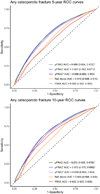A Fracture Risk Assessment Tool for High Resolution Peripheral Quantitative Computed Tomography
- PMID: 37132542
- PMCID: PMC10523935
- DOI: 10.1002/jbmr.4808
A Fracture Risk Assessment Tool for High Resolution Peripheral Quantitative Computed Tomography
Abstract
Most fracture risk assessment tools use clinical risk factors combined with bone mineral density (BMD) to improve assessment of osteoporosis; however, stratifying fracture risk remains challenging. This study developed a fracture risk assessment tool that uses information about volumetric bone density and three-dimensional structure, obtained using high-resolution peripheral quantitative compute tomography (HR-pQCT), to provide an alternative approach for patient-specific assessment of fracture risk. Using an international prospective cohort of older adults (n = 6802) we developed a tool to predict osteoporotic fracture risk, called μFRAC. The model was constructed using random survival forests, and input predictors included HR-pQCT parameters summarizing BMD and microarchitecture alongside clinical risk factors (sex, age, height, weight, and prior adulthood fracture) and femoral neck areal BMD (FN aBMD). The performance of μFRAC was compared to the Fracture Risk Assessment Tool (FRAX) and a reference model built using FN aBMD and clinical covariates. μFRAC was predictive of osteoporotic fracture (c-index = 0.673, p < 0.001), modestly outperforming FRAX and FN aBMD models (c-index = 0.617 and 0.636, respectively). Removal of FN aBMD and all clinical risk factors, except age, from μFRAC did not significantly impact its performance when estimating 5-year and 10-year fracture risk. The performance of μFRAC improved when only major osteoporotic fractures were considered (c-index = 0.733, p < 0.001). We developed a personalized fracture risk assessment tool based on HR-pQCT that may provide an alternative approach to current clinical methods by leveraging direct measures of bone density and structure. © 2023 The Authors. Journal of Bone and Mineral Research published by Wiley Periodicals LLC on behalf of American Society for Bone and Mineral Research (ASBMR).
Keywords: BONE MICROARCHITECTURE; FRACTURE PREDICTION; HIGH RESOLUTION PERIPHERAL QUANTITATIVE COMPUTED TOMOGRAPHY; MACHINE LEARNING; OSTEOPOROSIS; RISK ASSESSMENT.
© 2023 The Authors. Journal of Bone and Mineral Research published by Wiley Periodicals LLC on behalf of American Society for Bone and Mineral Research (ASBMR).
Conflict of interest statement
All other authors declare they have no conflicts of interest.
Figures




Comment in
-
The Added Value of High-Resolution Peripheral Quantitative Computed Tomography in Fracture Risk Prediction.J Bone Miner Res. 2023 Sep;38(9):1225-1226. doi: 10.1002/jbmr.4909. Epub 2023 Sep 13. J Bone Miner Res. 2023. PMID: 37702108 No abstract available.
References
-
- NIH-Panel. NIH Consensus Development Panel on Osteoporosis Prevention, Diagnosis, and Therapy: Osteoporosis prevention, diagnosis, and therapy. JAMA. Feb 14 2001;285(6):785–95. - PubMed
-
- Seeman E. Pathogenesis of bone fragility in women and men. Lancet. May 25 2002;359(9320):1841–50. - PubMed
-
- Cheng XG, Lowet G, Boonen S, Nicholson PH, Brys P, Nijs J, et al. Assessment of the strength of proximal femur in vitro: relationship to femoral bone mineral density and femoral geometry. Bone. Mar 1997;20(3):213–8. Epub 1997/03/01. - PubMed
-
- NIH Consensus Development Panel on Osteoporosis Prevention, Diagnosis, and Therapy, March 7–29, 2000: highlights of the conference. South Med J. Jun 2001;94(6):569–73. - PubMed
-
- Lorentzon M, Cummings SR. Osteoporosis: the evolution of a diagnosis. J Intern Med. Jun 2015;277(6):650–61. Epub 2015/04/03. - PubMed
Publication types
MeSH terms
Grants and funding
LinkOut - more resources
Full Text Sources
Medical
Miscellaneous

